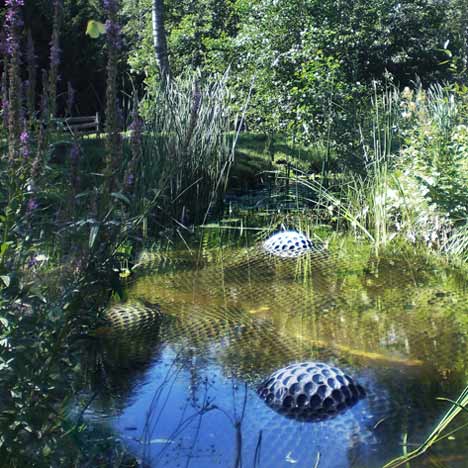
Swedish architects Visiondivision have created this undulating concrete habitat for crayfish in a stream in Sweden.

Cancer City was commissioned by a crayfish enthusiast who wanted to prevent crayfish emigrating to a neighbouring lake from his stream, where there was a lack of rocks, nooks and crannies.

The honeycomb surface is punctured in places to allow the fish to seek refuge underneath.

The peaks of the structure have removable lids to allow access to these protected areas during hunting.

A painted white line and underwater LED’s allow hunting to take place at night when crayfish are most active.

The structure, which is strong enough to walk on but also light enough to be carried without machinery, is made from a new type of concrete called Butong.

The concrete is formed between a sandwich of flexible layers and contains the mineral calcite, which attracts crayfish.
Click above for larger image
Here’s some more from the designers:
“A country gentlemen once bought 10000 crayfishes in the 90’s to plant in a stream running through his land. In the autumn he would capture about a hundred of them to eat at the annual Swedish crayfish parties. The crayfishes however slowly started to emigrate to another nearby lake outside the patron’s estate. Desperate of seeing his neighbors feast on his crayfishes, he contacted visiondivision to solve his problem.
Visiondivision decided to help the patron by building him a refugee where the crayfishes could imigrate back. By investigating the condition of the stream we soon found out that it was the lack of stones, hiding places and the lack of calcite that probably had made the crayfishes emigrate. The city planning would focus on solving these issues.
Click above for larger image
The design became an undulated concrete landscape where the crayfish live inside the hills. The hills are equipped with lids so the gentleman can walk on top of the landscape, capturing his yearly crayfish quota. A white path runs on the construction so the hunter can hunt at night time when the crayfish are as most active. Water proof LED lights are attached inside the hills that attract the crayfish and make them visible for the hunter. The hills have several escape holes and underground safe zones so the hunting won’t be too easy which would be unjust to the crayfishes.
Click above for larger image
The choice of material was crucial for the success of the project. The construction obviously should be water resistance, the city should be strong enough to carry some full grown persons or animals walking on it, the city should also provide shelter to the crayfishes and the construction should not be too heavy since it should be moved to a remote place where no machines can go. The choice of material became “Butong”; a lightweight slightly transparent concrete invented by the firm with the same name.
Click above for larger image
Butong is only two centimeters in depth without any metal reinforcement that can rust and the mould could be bendable after casting which enabled us to make an undulated landscape of concrete without having to build time consuming casting forms. Another attribute with Butong is that it includes calcite; a substance that attracts crayfishes.
The exquisite concrete endeavour is now resting in the stream waiting for its inhabitants to arrive. Walking on the flawless craftsmanship just one week after inauguration we met one of the first inhabitants staring at us from its new nest.”
Credits: visiondivision through Anders Berensson & Ulf Mejergren
Butong team: Lars Höglund & Benjamin Levy








所有评论